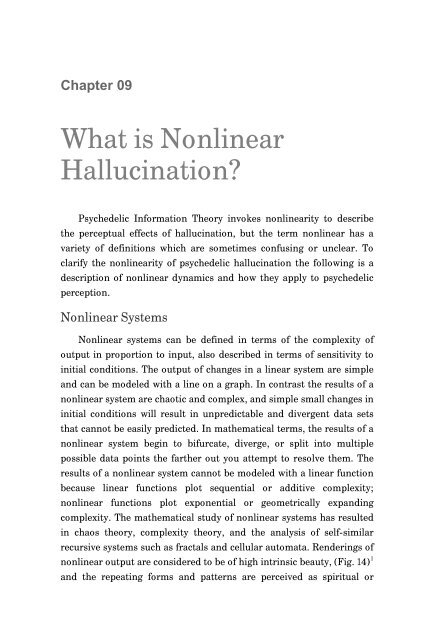Psychedelic-information-theory-Shamanism-in-the-age-of-Reason
Psychedelic-information-theory-Shamanism-in-the-age-of-Reason
Psychedelic-information-theory-Shamanism-in-the-age-of-Reason
- No tags were found...
Create successful ePaper yourself
Turn your PDF publications into a flip-book with our unique Google optimized e-Paper software.
Chapter 09What is Nonl<strong>in</strong>earHalluc<strong>in</strong>ation?<strong>Psychedelic</strong> Information Theory <strong>in</strong>vokes nonl<strong>in</strong>earity to describe<strong>the</strong> perceptual effects <strong>of</strong> halluc<strong>in</strong>ation, but <strong>the</strong> term nonl<strong>in</strong>ear has avariety <strong>of</strong> def<strong>in</strong>itions which are sometimes confus<strong>in</strong>g or unclear. Toclarify <strong>the</strong> nonl<strong>in</strong>earity <strong>of</strong> psychedelic halluc<strong>in</strong>ation <strong>the</strong> follow<strong>in</strong>g is adescription <strong>of</strong> nonl<strong>in</strong>ear dynamics and how <strong>the</strong>y apply to psychedelicperception.Nonl<strong>in</strong>ear SystemsNonl<strong>in</strong>ear systems can be def<strong>in</strong>ed <strong>in</strong> terms <strong>of</strong> <strong>the</strong> complexity <strong>of</strong>output <strong>in</strong> proportion to <strong>in</strong>put, also described <strong>in</strong> terms <strong>of</strong> sensitivity to<strong>in</strong>itial conditions. The output <strong>of</strong> changes <strong>in</strong> a l<strong>in</strong>ear system are simpleand can be modeled with a l<strong>in</strong>e on a graph. In contrast <strong>the</strong> results <strong>of</strong> anonl<strong>in</strong>ear system are chaotic and complex, and simple small changes <strong>in</strong><strong>in</strong>itial conditions will result <strong>in</strong> unpredictable and divergent data setsthat cannot be easily predicted. In ma<strong>the</strong>matical terms, <strong>the</strong> results <strong>of</strong> anonl<strong>in</strong>ear system beg<strong>in</strong> to bifurcate, diverge, or split <strong>in</strong>to multiplepossible data po<strong>in</strong>ts <strong>the</strong> far<strong>the</strong>r out you attempt to resolve <strong>the</strong>m. Theresults <strong>of</strong> a nonl<strong>in</strong>ear system cannot be modeled with a l<strong>in</strong>ear functionbecause l<strong>in</strong>ear functions plot sequential or additive complexity;nonl<strong>in</strong>ear functions plot exponential or geometrically expand<strong>in</strong>gcomplexity. The ma<strong>the</strong>matical study <strong>of</strong> nonl<strong>in</strong>ear systems has resulted<strong>in</strong> chaos <strong><strong>the</strong>ory</strong>, complexity <strong><strong>the</strong>ory</strong>, and <strong>the</strong> analysis <strong>of</strong> self-similarrecursive systems such as fractals and cellular automata. Render<strong>in</strong>gs <strong>of</strong>nonl<strong>in</strong>ear output are considered to be <strong>of</strong> high <strong>in</strong>tr<strong>in</strong>sic beauty, (Fig. 14) 1and <strong>the</strong> repeat<strong>in</strong>g forms and patterns are perceived as spiritual or


